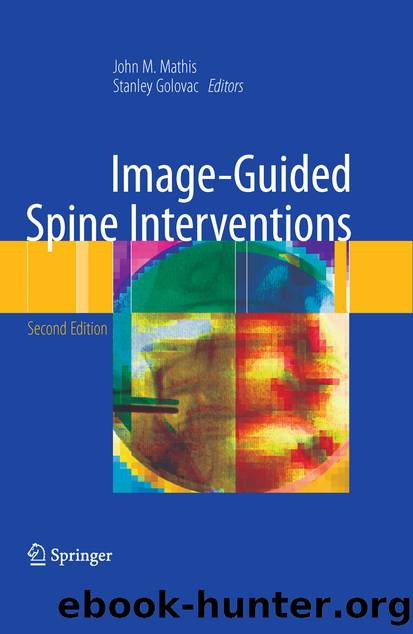Image-Guided Spine Interventions by John M. Mathis & Stanley Golovac

Author:John M. Mathis & Stanley Golovac
Language: eng
Format: epub
Publisher: Springer New York, New York, NY
Indications
The procedure is indicated for patients with shoulder pain who have been evaluated by a shoulder specialist and found not to be a candidate for surgery. Many of these patients have had a prior rotator cuff repair and still have pain. It is also indicated for patients with a frozen shoulder from any cause. Patients must have responded positively (70-100% reduction in pain) to blockade of the nerve with local anesthetic on two separate occasions are candidates for PRF.
Technique
Fluoroscopy is used to perform the procedure. The patient is placed in a prone position on the table. It can sometimes be difficult to visualize the suprascapular notch. The technique is to angle the c-arm in a cephalo-caudal direction and then oblique towards the affected side. The suprascapular notch is identified just above the spine of the scapula and medial to the coricoid process.47 After sterile prep and drape, a 5 cm RFK needle with a 4 mm active tip is advanced down the angle of the X-ray beam in order to position the needle perpendicular to the nerve (Figure 9.9a, b). Next, the nerve is stimulated at 50 Hz with the intention of obtaining a paresthesia in the shoulder at less than 0.2 V. This should be repeated to test for reproducibility. It is not necessary to perform motor stimulation, as PRF does not affect motor fibers. Then the impedance is checked. It should register at less than 400 ohms. If not, saline is injected. It is important not to numb the targeted nerve in order to ensure that the patient feels continued pulsing throughout the entire procedure. Finally, the nerve is lesioned in the pulsed mode for 4 min at 2 Hz, and 45-60 V. It is not necessary to measure temperature as long as it stays below 42°C. The operator should hold the needle in place throughout the procedure and occasionally ask the patient if they continue to feel pulsing. If not, it implies that the tip has moved away from the targeted nerve and is no longer producing any effect. A visible pulsation of the supraspinatus and infraspinatus muscles will be seen.47
Figure 9.9.(A) This is an image of a 5-cm needle directed at the suprascapular nerve located within the notch. (B) This provides a good view of the suprascapular notch with a RF needle located medial to the target point.
Download
This site does not store any files on its server. We only index and link to content provided by other sites. Please contact the content providers to delete copyright contents if any and email us, we'll remove relevant links or contents immediately.
| Anesthesiology | Colon & Rectal |
| General Surgery | Laparoscopic & Robotic |
| Neurosurgery | Ophthalmology |
| Oral & Maxillofacial | Orthopedics |
| Otolaryngology | Plastic |
| Thoracic & Vascular | Transplants |
| Trauma |
When Breath Becomes Air by Paul Kalanithi(7253)
Why We Sleep: Unlocking the Power of Sleep and Dreams by Matthew Walker(5636)
Paper Towns by Green John(4163)
The Immortal Life of Henrietta Lacks by Rebecca Skloot(3820)
The Sports Rules Book by Human Kinetics(3581)
Dynamic Alignment Through Imagery by Eric Franklin(3481)
ACSM's Complete Guide to Fitness & Health by ACSM(3459)
Kaplan MCAT Organic Chemistry Review: Created for MCAT 2015 (Kaplan Test Prep) by Kaplan(3418)
Introduction to Kinesiology by Shirl J. Hoffman(3297)
Livewired by David Eagleman(3113)
The River of Consciousness by Oliver Sacks(2988)
Alchemy and Alchemists by C. J. S. Thompson(2908)
The Death of the Heart by Elizabeth Bowen(2895)
Descartes' Error by Antonio Damasio(2728)
Bad Pharma by Ben Goldacre(2722)
The Gene: An Intimate History by Siddhartha Mukherjee(2487)
Kaplan MCAT Behavioral Sciences Review: Created for MCAT 2015 (Kaplan Test Prep) by Kaplan(2483)
The Fate of Rome: Climate, Disease, and the End of an Empire (The Princeton History of the Ancient World) by Kyle Harper(2429)
The Emperor of All Maladies: A Biography of Cancer by Siddhartha Mukherjee(2427)
